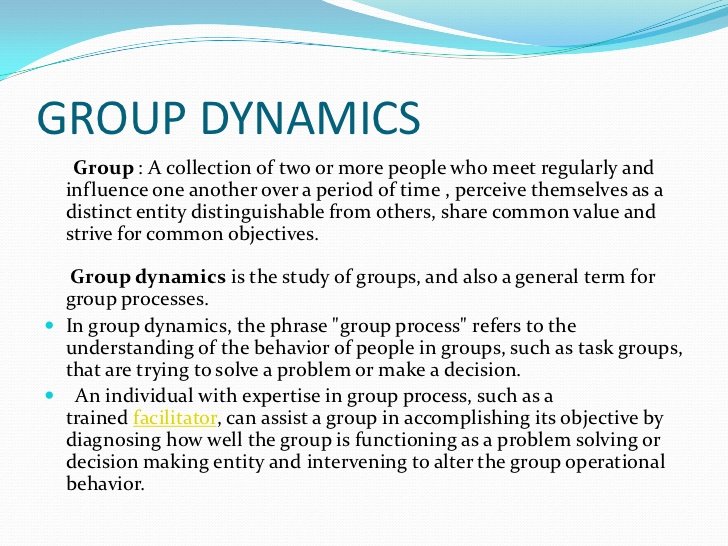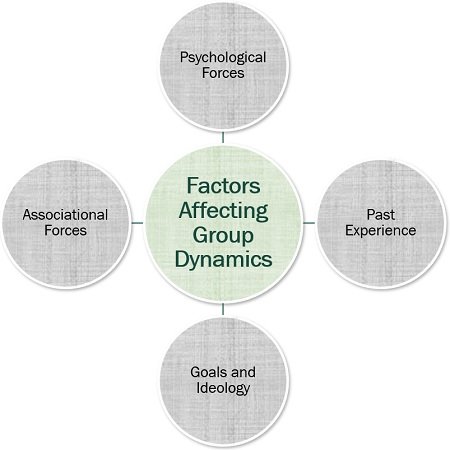The term ‘group dynamics’ means the study of forces within a group. Since human beings have an innate desire for belonging to a group, group dynamism is bound to occur. In an organization or in a society, we can see groups, small or large, working for the well-being.
The social process by which people interact with one another in small groups can be called group dynamism. A group has certain common objectives & goals. Because of which members are bound together with certain values and culture.
Group dynamics deals with the attitudes and behavioral patterns of a group. Group dynamics concern how groups are formed, what is their structure and which processes are followed in their functioning. Thus, it is concerned with the interactions and forces operating between groups.
Importance/Role of Group Dynamics
- Firstly, a group can influence the way the members think. The members are always influenced by the interactions of other members in the group. A group with a good leader performs better as compared to a group with a weak leader.
- The group can give the effect of synergy, that is, if the group consists of positive thinkers then its output is more than double every time.
- Group dynamism can furthermore give job satisfaction to the members.
- The group can also infuse the team spirit among the members.
- Even the attitude, insights & ideas of members depend on group dynamism. For example, negative thinkers convert to positive thinkers with the help of the facilitator.
- Also, if the group works as a cohesive group, the cooperation and convergence can result in maximization of productivity
- Furthermore, group dynamism can reduce labor unrest. Lastly, it reduces labor turnover due to emotional attachment among the group members.

Process/Stages of Group Dynamics
Group Development is a dynamic process. How do groups evolve? There is a process of five stages through which groups pass through. The process includes the five stages: forming, storming, forming, performing, and adjourning.
-
Forming
The first stage in the life of a group is concerned with forming a group. This stage is characterized by members seeking either a work assignment (in a formal group) or other benefit, like status, affiliation, power, etc. (in an informal group). Members at this stage either engage in busy type of activity or show apathy.
-
Storming
The next stage in this group is marked by the formation of dyads and triads. Members seek out familiar or similar individuals and begin a deeper sharing of self. Continued attention to the subgroup creates a differentiation in the group and tensions across the dyads / triads may appear. Pairing is a common phenomenon. There will be conflict about controlling the group.
-
Norming
The third stage of group development is marked by a more serious concern about task performance. The dyads/triads begin to open up and seek out other members in the group. Efforts are made to establish various norms for task performance.
Members begin to take greater responsibility for their own group and relationship while the authority figure becomes relaxed. Once this stage is complete, a clear picture will emerge about hierarchy of leadership. The norming stage is over with the solidification of the group structure and a sense of group identity and camaraderie.
-
Performing
This is a stage of a fully functional group where members see themselves as a group and get involved in the task. Each person makes a contribution and the authority figure is also seen as a part of the group. Group norms are followed and collective pressure is exerted to ensure the Process of Group effectiveness of the group.
The group may redefine its goals Development in the light of information from the outside environment and show an autonomous will to pursue those goals. The long-term viability of the group is established and nurtured.clip_image002
-
Adjourning
In the case of temporary groups, like project team, task force, or any other such group, which have a limited task at hand, also have a fifth stage, This is known as adjourning.
The group decides to disband. Some members may feel happy over the performance, and some may be unhappy over the stoppage of meeting with group members. Adjourning may also be referred to as mourning, i.e. mourning the adjournment of the group.
The readers must note that the four stages of group development mentioned above for permanent groups are merely suggestive. In reality, several stages may go on simultaneously.

Types of Groups
One way to classify the groups is by way of formality, formal and informal. While formal groups are established by an organization to achieve its goals, informal groups merge spontaneously. Formal groups may take the form of command groups, task groups, and functional groups.
-
Command Groups
Command groups are specified by the organizational chart and often consist of a supervisor and the subordinates that report to that supervisor. An example of a command group is a market research firm CEO and the research associates under him.
-
Task Groups
Task groups consist of people who work together to achieve a common task. Members are brought together to accomplish a narrow range of goals within a specified time period. Task groups are also commonly referred to as task forces. The organization appoints members and assigns the goals and tasks to be accomplished.
Examples of assigned tasks are the development of a new product, the improvement of a production process, or designing the syllabus under semester system.
Other common task groups are ad hoc committees, project groups, and standing committees. Ad hoc committees are temporary groups created to resolve a specific complaint or develop a process are normally disbanded after the group completes the assigned task.
-
Functional Groups
A functional group is created by the organization to accomplish specific goals within an unspecified time frame. Functional groups remain in existence after achievement of current goals and objectives. Examples of functional groups would be a marketing department, a customer service department, or an accounting department.